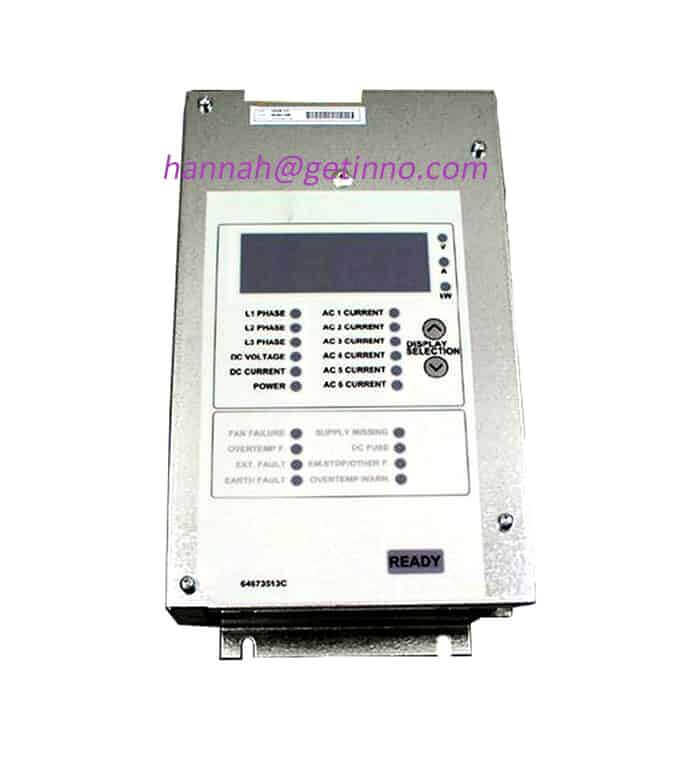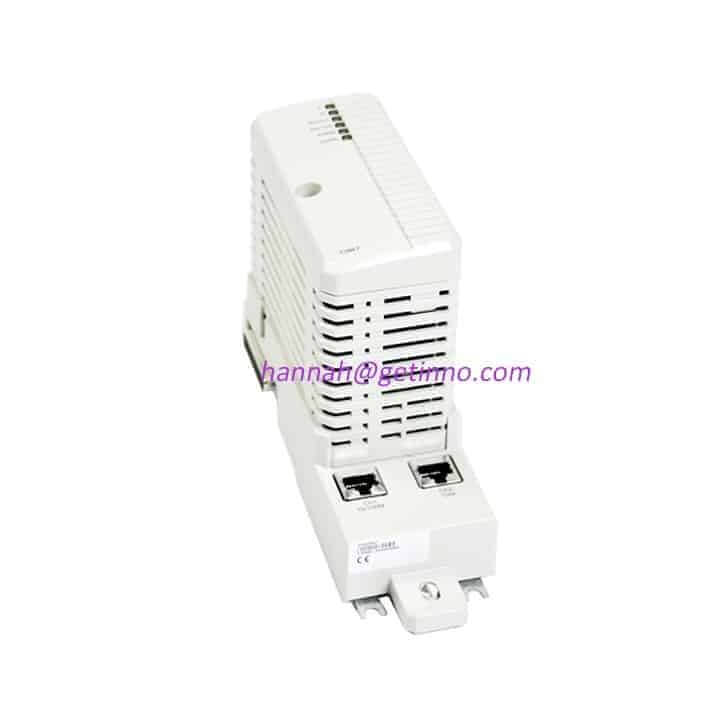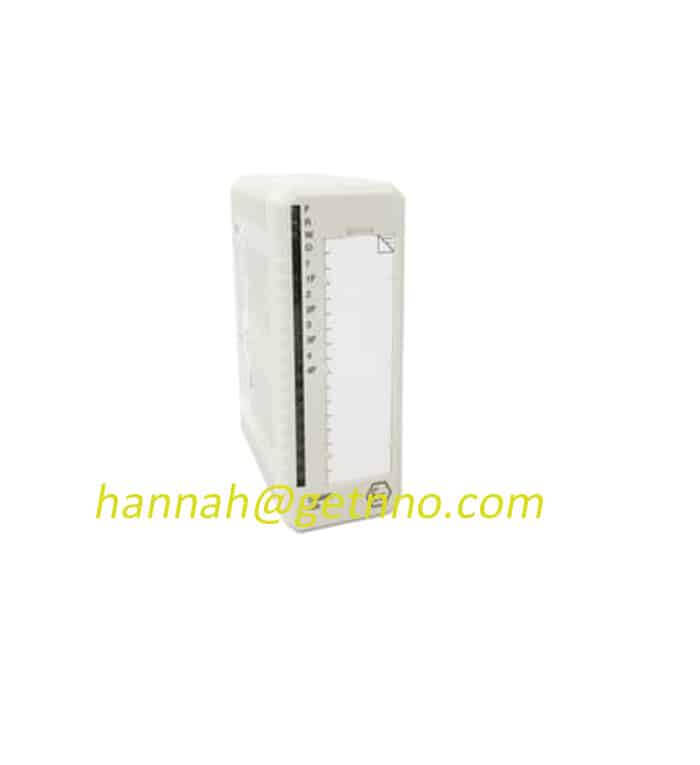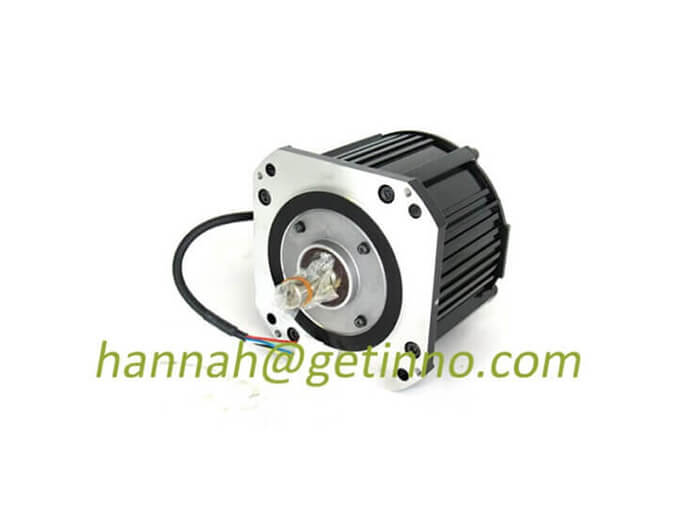Status Quo and Enlightenment of Global Patent Layout of Industrial Robot Technology
In 1920 Czech writers described aRobotIt is the earliest idea of industrial robots. With the development of science and technology, the concept of industrial robots was first proposed by Davor in the United States in 1954, the patent was applied in 1958, and the first in the United States was born in 1959. Industrial robots. For more than 50 years, industrial robots have gone through three stages: programmable teaching and reproducible robots, perceptual judgment robots, and intelligent robots, and their application fields have gradually shifted from the civilian field of industrial production to the military field.
1. Overview of global patent applications in the field of industrial robots
As of July 2014, the number of global patent applications in the field of industrial robotics has exceeded 60,000, and there are more than 35,000 patent families. The earliest patent application appeared in 1958, and it was not until 1985 that the number of patent applications began to increase significantly. Patent layout in China. At present, industrial robot technology is in a period of rapid development.
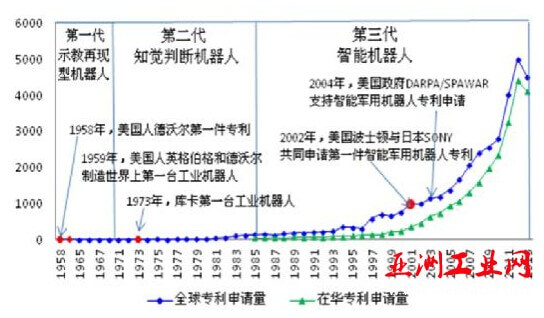
Figure 1 Trend of global patent applications in the field of industrial robotics
(1) The stage of technological development
From the perspective of technological development, industrial robot technology has gone through three stages:
The first stage (1958-1969) programmable teaching and reproducible robot: The first patent in the field of industrial robots was applied by American George Devol in 1958, called a programmable operating device.Joseph Engelberg was very interested in this patent, and in 1959, he and Devol jointly produced the world’s first industrial robot called Robot (Chinese translation robot), that is, a human hand heldmechanicalHands, do the tasks that should be completed, and the robots repeat the work according to the programs taught to them in advance. They are mainly used in industrial production fields such as casting, forging, stamping, welding, etc., and are specially called industrial robots.
The second stage (1970-1984) perceptual judgment robot: The industrial robot in this stage is an offline programming robot with certain sensory function and adaptive ability. “Perceptual Judgment Robots”. During the period, the “Four Families” of industrial robots: KUKA, ABB, Yaskawa, and FANUC started the global patent layout in 1974, 1976, 1978 and 1979 respectively.
The third stage (1985-present) intelligent robot: At this stage, the robot has a variety of sensors, which can fuse the information obtained by a variety of sensors, can effectively adapt to the changing environment, and have strong adaptive and learning capabilities. and autonomous functions. After 2000, the United States, Japan and other countries started the research on intelligent military robots, and in 2002, the Boston company of the United States and the Japanese company jointly applied for the first patent of “Mechanical Dog” (Boston Dynamics BigDog) intelligent military robot. Under the support of DRAPA/SPAWAR of the United States, it applied for a patent for an intelligent military robot.
(2) Global layout
1. Country/regional distribution of patent acceptance in the field of industrial robots
From the ranking of the top six countries/regions (patent acceptance agencies, based on patent family countries) in the number of industrial robot-related patents accepted, it can be seen that the countries/regions with the largest number of related patents are: China, Japan, South Korea, and the United States. , European Patent Office. This also reflects that China, Japan, South Korea, and the United States are the main markets for industrial robots.
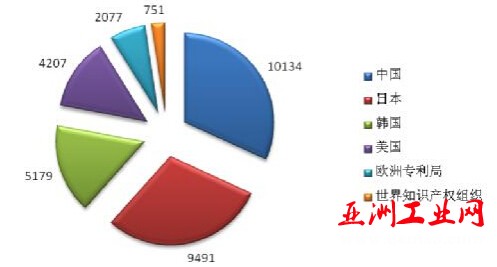
Figure 2 Country/regional distribution of patent acceptance in the field of industrial robots
2. Overview of technology layout in the field of industrial robots
The figure below shows the global technology layout in the field of industrial robots. Most of the patents are distributed in the structure, control, touch, safety and program control technology of the manipulator, as well as the channel control, automatic control, transmission, and multi-articulated claw arm technology of industrial robots.
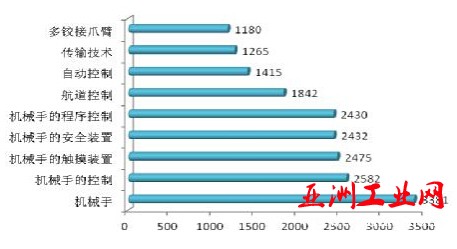
Figure 3 Technology layout in the field of industrial robots
3. Analysis of China’s patent applications
my country’s industrial robots started in 1972, and its development process can be roughly divided into three stages: the budding period from 1972 to 1985; the technology research and development period from 1985 to 2000; and the industrialization period from 2000 to the present.
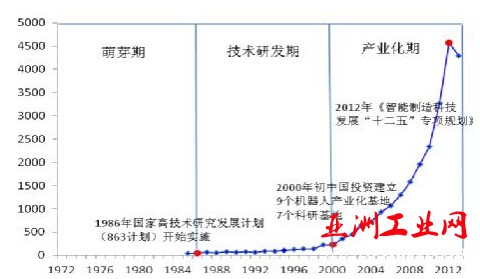
Figure 4 Patent applications for industrial robots in China
At present, my country has produced some key components of robots, and developed industrial robots such as arc welding, spot welding, palletizing, assembly, handling, injection molding, stamping, and painting. A number of domestic industrial robots have served the production lines of some domestic enterprises; a number of research talents in robotics have also emerged. Some military enterprises, scientific research institutions and enterprises have mastered technologies such as optimal design and manufacture of industrial robot manipulators, industrial robot control, hardware design of drive systems, design and programming of robot software, kinematics and trajectory planning, and some key technologies even Has reached or approached the world advanced level.However, according to patent application data in China, ABB in Switzerland, FANUC in Japan, YASKAWA in Japan (Yaskawa)motor), Germany’s KUKA (KUKA) has applied for a large number of patents in my country. In contrast, Chinese applicants are mainly concentrated in Suzhou Industrial Park Vocational and Technical College, Kunshan Industrial Technology Research Institute, Hunan University, Tsinghua University and other universities. The scientific research institutes and enterprises with technological advantages in my country do not pay much attention to the patent layout in the field of industrial robot technology. .
2. Overview of main competitors
In the civil field, the “four major families” that occupy most of the industrial robot market internationally: Yaskawa, FANUC, KUKA, and ABB have started global patent layout since the mid-1970s, and have been increasing year by year. At the same time, “China’s growth” has made the world’s leading industrial robot giants turn their attention to my country. ABB headquartered in Switzerland, Japan’s FANUC (Fanuc), Japan’s YASKAWA (Yaskawa Electric), and Germany’s KUKA (KUKA) are all at the same time. Land Capital has its China headquarters in Shanghai. At present, these four companies have a total market share of more than 80% in China, and the sales of the top three robots in the world have exceeded 200,000 units.
In the military sector, U.S. government-backed military robot developers account for 85 percent of the global military robot market, with Europe accounting for 15 percent and China’s only 0.1 percent. General Dynamics, the leader in military robotics, has a market share of 27%, followed by Northrop Grumman and Lockheed Martin.
(1) Yaskawa Electric (Yaskawa)
In 1915, Yaskawa Electric Works, a joint venture company, was established. Since Yaskawa Electric developed the first all-electric industrial robot in 1977, it has owned subsidiaries such as Motoman USA, Sweden, Germany and Synetics Solutions USA. So far, it has produced more than 130,000 robot products, and in the past two years, the number of robots produced has reached 3. More than 10,000 units, more than other robot manufacturing companies. In April 2005, the company announced that it would invest 400 million yen to build a new robot manufacturing plant, with a monthly production capacity of 2,000 industrial robots. Yaskawa has applied for 4,505 robot-related patents worldwide, and 1,949 patents in the same family.
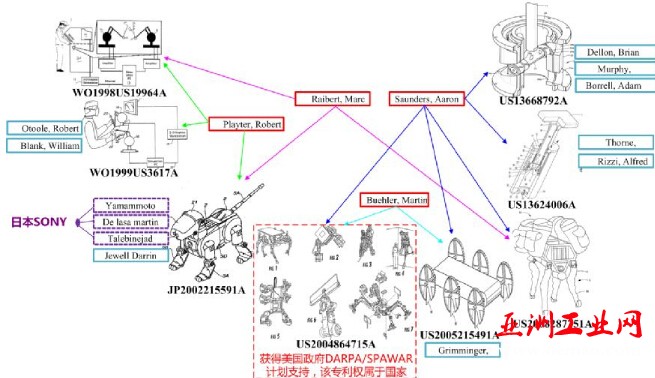
Figure 5 Yaskawa Electric’s patent applications
(2) Japan FANUC
FANUC, founded in 1956, is the most powerful enterprise in the world in terms of scientific research, design, manufacturing and sales of CNC systems. R&D personnel account for 1/3 of the company’s total number. In 1974, FANUC was based on Servo, numerical control basic industrial robots came out and put on the market in 1976. FANUC has applied for 5,507 robot-related patents worldwide, and 1,476 patents in the same family.
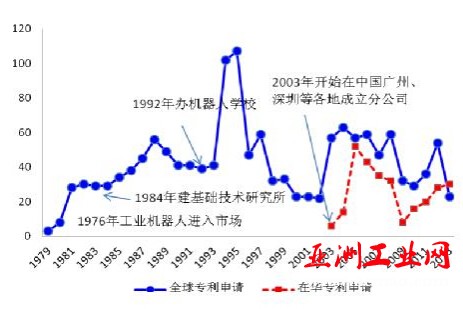
Figure 6 Patent application of FANUC
(3) KUKA, Germany
Founded in 1898 and headquartered in Augsburg, Germany, KUKA provides flexibility for automotive, aerospace, energy and industrial fields.automationsystem equipment company. September 2000, KUKAautomation equipment(Shanghai) Co., Ltd. was formally established. In July 2004, KUKA Flexible System Manufacturing (Shanghai) Co., Ltd. was established in Shanghai Qingpu Industrial Park. In December 2008, the “KUKA Welding Robot Intelligence and Engineering Application Joint Laboratory” was established in Shanghai Jiaotong University. KUKA has applied for 2,383 robot-related patents worldwide, and 802 patents in the same family.
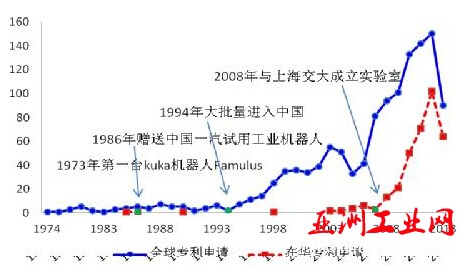
Figure 7 Patent application of German KUKA company
(4) ABB Switzerland
ABB was formed in 1988 by the merger of two international companies with a history of more than 100 years: ASEA in Sweden (ASEA) and BBC Brown Boveri in Switzerland. The two companies were established in 1883 and 1891 respectively. . The ABB Group has operations in more than 100 countries and 107,000 employees. More than half of the ABB Group’s turnover comes from the European market, nearly a quarter from Asia, the Middle East and Africa, and a fifth from the North and South American markets. ABB has applied for 3,389 robot-related patents worldwide, and 923 patents in the same family.
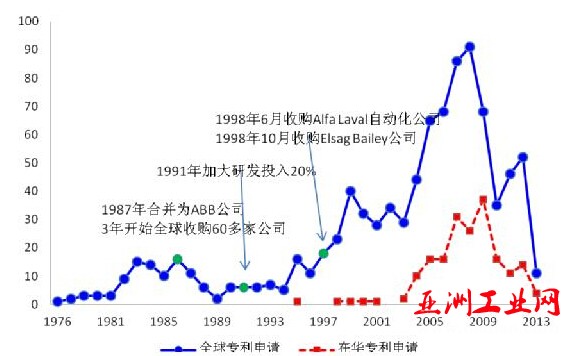
Figure 8 Patent applications of ABB in Switzerland
(5) Boston Dynamics
Boston Dynamics has applied for 8 patents since 1998, including 5 in the United States. One of the invention patents, US2004864715A, was supported by the US government’s DARPA/SPAWAR program, and the patent right belongs to the country.
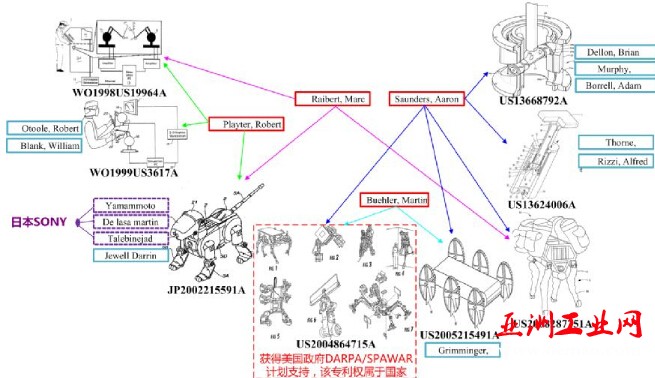
Figure 9. Research and development status of Boston Dynamics intelligent robots. Boston Dynamics BigDog is a dynamic balance quadruped robot. Station joint research and development.

Figure 10 The correspondence between Boston Dynamics’ intelligent robot products and patents
The patent JP2002215591A pet robot applied for in July 2002 revealed the technical source of Boston Dynamics’ original intelligent quadruped bionic robot BigDog. The patent shows that the related technology was jointly developed by Japan’s SONY and Boston Dynamics, and related patents are jointly owned by both parties. This patent discloses the use of a helical spring to maintain the linear relationship between the servo motor and the leg tip, and gives a specific implementation method and related experimental data.
3. Inspiration and suggestion
First, in-depth analysis of the intellectual property risks faced by the domestic and foreign industrial robot markets. Four major companies, Yaskawa, FANUC, KUKA, and ABB, started global patent applications in the 1970s, and started patent layout in China in 1995, 2003, 1985, and 1996, especially KUKA’s patents in China. The largest number of applications. The technical features of some of the patents applied by the four major companies are similar to the related industrial robot products of some domestic companies. It is recommended to do detailed patent infringement analysis for specific products in the future. Most of the domestic industrial robot-related technologies are still in the research and development stage. On the one hand, we can evade design or adjust the research and development route according to the patent status of key technologies to avoid subsequent intellectual property risks; on the other hand, we can target specific urgent technical problems and difficulties. Look for technical solutions in the patent literature.
The second is to use patents as a breakthrough to carry out the industrialization of industrial robot technology. Judging from the patent application trends of the four major civil companies, the time point of each technology industrialization is the peak of the number of patent applications, especially Japanese companies. Patents are the umbrella for products to enter the market, and the timing and geographical selection of patent applications are closely related to the direction of industrialization. For example, the Japanese company FANUC had never applied for robot-related patents in China before 2003, mainly to prevent leakage of related technologies, but in 2003, it set up nearly ten branches in Guangzhou, Shenzhen and other places in China, and started in China in the same year. The number of patent applications has risen sharply, which can not only protect its own products, but also curb the development of competitors.
The third is to acquire and acquire companies with technological research and development capabilities to enhance competitiveness. Mergers and acquisitions of domestic and foreign related enterprises with independent intellectual property rights, strong R&D teams and leading market positions have gradually become an important way for domestic enterprises to rapidly increase their scale, enhance their core competitiveness, and quickly complete their international business layout. A convenient way for military-civilian integrated development, rapid industrial transformation and upgrading and structural adjustment. On the one hand, it can directly obtain a large number of patents, and on the other hand, it can obtain a team with R&D strength. For example, ABB has acquired more than 60 companies around the world within 3 years since 1987, but the robotics technology has not developed rapidly, but since the acquisition of Alfa Laval Automation in June 1998 and the acquisition of Elsag Bailey in October 1998, the robot Related patent applications rose sharply, and since then it has maintained its technological advantages. In addition, KUKA is a German company, which is easier for technical cooperation than the United States and Japan, and KUKA entered the Chinese market earlier, which shows that it has a high degree of attention to the Chinese market. In 1986, it entered the China FAW Industrial Robot in a friendly way China, KUKA and Shanghai Jiaotong University jointly established a laboratory in 2008. At the same time, KUKA has a large number of patent applications in China, and already has certain technological advantages, which can avoid more intellectual property risks in combination with it.
Fourth, the transformation and application of industrial robot technology should pay attention to “civilian-to-military”. After 2000, the United States gradually began to transform industrial robot technology into the military field, and in 2011 released the National Robotics Initiative (NRI) for three types of robots: manufacturing, health care/medical robots, and service robots. The technology development roadmap, but the US robotics technology development roadmap released in 2013 added a new robotics technology development plan for aerospace and defense. At the same time, the United States pays great attention to the protection of relevant intellectual property rights when it spends huge amounts of money on military robots. For example, Boston Dynamics’ invention patent US2004864715A shows that the patent has been supported by the US government’s DARPA/SPAWAR program, and it also stipulates that its patent rights belong to the country; On the other hand, the research and development of military robots in the United States has adopted multi-party cooperation. For example, the original technology of Boston BigDog came from the joint research and development of Japanese company SONY and Boston Dynamics. According to other media reports, this model also cooperated with Foster-Miller, Joint development by Jet Propulsion Laboratory and Harford University’s Conderfield Research Station.
It is recommended that domestic enterprises carry out complete patent analysis and evaluation in the industrial Robot Industry demonstration. Carrying out patent analysis of key technologies can improve the starting point of technology research and development, optimize resource allocation, speed up the research process, achieve breakthroughs in key technologies and carry out re-innovation, so as to rapidly improve technological innovation. At the same time, master the patent layout of foreign benchmarking companies, find out the gap between model development and foreign technical indicators, and meet the urgent need for scientific and technological intelligence support information in the research and development process. On this basis, combined with the technical advantages and technical disadvantages of the industrial robot industry of enterprises, analyze foreign high-tech hotspots, blank spots, development trends and directions, propose intellectual property layout suggestions for the industry, and provide decision-making support for strategic research, project demonstration, and project approval. .
(Contributor: Li Ping, Zhang Yue, Zhou Ziyan, Gan Shu, Intellectual Property Research Center of China Aerospace Science and Industry Corporation, Reviewer: Ma Shuhui)
The Links: 3BSE032401R1 3HAC025562-001
Pre: DJI and Qianxun have reached a strate... Next: In the era of edge computing, discuss...

